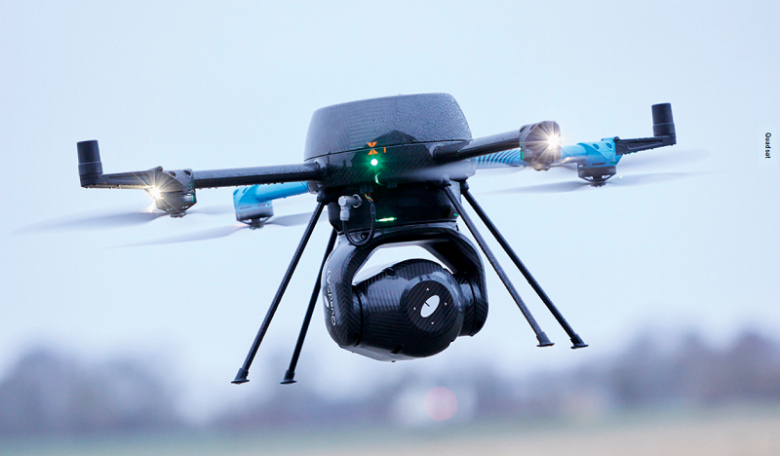Phased array antennas (PAA) offer huge benefits to satellite communications: their ability to change the shape and direction of an antenna beam without physically moving the antenna enables enhanced connectivity and dynamic networks. As with all antenna terminals, testing is crucial in optimising performance and connectivity within satcom infrastructures. The specific challenge associated with PAAs is that the radiation pattern changes depending on the steering angle, which makes it difficult to evaluate every possible radiation pattern. This article considers how the dynamic capabilities of drones can be applied to antenna testing and utilised to improve the testing of PAAs.
The phased array antenna market is set to grow at a compound annual growth rate (CAGR) of 8.3 percent from 2022 to 2028, reaching US $5,773.8 million by 2028 (MarketWatch). Although a little more conservative, a report by Strategic Market Research also predicts large growth for this sector, estimating a value of US $4,662.08 million for all types of flat panel antennas by 2023.
There are a number of contributing factors for this growth, which include the rising demand for compact antenna systems for communications on the move (COTM) applications, as well as increasing investments in space exploration and a growing number of satellite launches. The market is experiencing an increasing adoption of low-cost antennas that operate at both commercial and military frequencies.
Indeed, satellites continue to be vital for ensuring connectivity, especially where required for safety, but equally they are still core for global communication and entertainment. This is especially true where terrestrial networks are weak or unavailable. At the same time, there is a growing demand for broadband connectivity on airlines, both to help ensure flight safety and to meet consumer demand to be connected everywhere at all times. This means that airlines and ferry and cruise operators are under increasing pressure to provide not only their own connectivity for operational services, but also to extend that to passengers, in order to ensure a good quality of service and customer experience while on the move.
Add to this the growing trend for connected and autonomous cars, which will only grow further over the coming years. Indeed, Allied Market Research values the global autonomous vehicle market at $76.13 billion in 2020, while it is estimated to grow at a CAGR of an astounding 40.1 percent to $2161.79 billion by 2030.
Compared to reflector antennas, planar antennas are very compact and deliver high aperture efficiency
Phased array antennas will undoubtedly be an essential tool for enabling this connectivity, whether for military or commercial satellites, because they allow instantaneous beam steering, which is particularly important in communications on the move scenarios where receiver position is constantly changing. This, coupled with a compactness that makes them easy to fit in small environments, is certainly going to drive that market further.
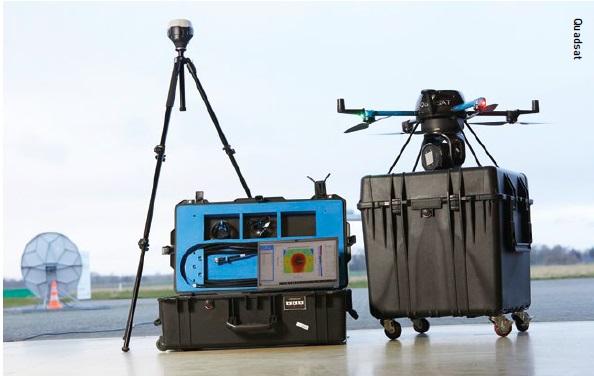 Vehicle-mounted satellite communications antennas provide reliable connectivity on the move over rough terrain and in harsh environments, which is essential for the military and for emergency services. Demand for compact antenna systems for communications on the move (COTM) applications is rising.
Vehicle-mounted satellite communications antennas provide reliable connectivity on the move over rough terrain and in harsh environments, which is essential for the military and for emergency services. Demand for compact antenna systems for communications on the move (COTM) applications is rising.
Role of testing
It is widely understood that testing is vital for all satellite systems, but it is particularly important for phased array antennas because the higher part-count can mean that they are even more susceptible to errors than traditional antennas. If the antenna is not working as it should, this can impact connectivity and potentially cause errors such as satellite interference. And of course, the very nature of where these types of antennas are installed means they are often relied upon as the only method of communication. Therefore, any downtime could be critical, and in certain circumstances, especially in military or first response environments, could be a matter of life or death.
Compared to reflector antennas, planar antennas are very compact and deliver high aperture efficiency. They can be steered mechanically or electronically. While mechanically steerable planar antennas can be useful for maintaining constant gain, they are relatively slow in scanning and not as accurate for tracking. Electronically steerable antennas enable instantaneous beam steering, which allows for much more accurate tracking of the satellite during fast manoeuvres, something that is essential for COTM applications.
When a COTM antenna is communicating with a satellite in low Earth orbit (LEO) and medium Earth orbit (MEO), the complexity of tracking increases further, making the use of electronically steerable antennas even more vital. However, if they are not operating correctly, this causes a significant problem for the entire operation and the only way to be sure is to carry out comprehensive testing.
Until now, phased array antenna radiation patterns have been evaluated in conventional facilities by measuring the entire sphere or plane from different steering angles. Testing these kinds of antennas, even in these dedicated environments, is extremely challenging because the radiation pattern changes depending on the steering angle. This means that you need to test and collect data for the entire radiation pattern, unlike fixed antennas where this doesn’t change. This is of course both complex and time consuming.
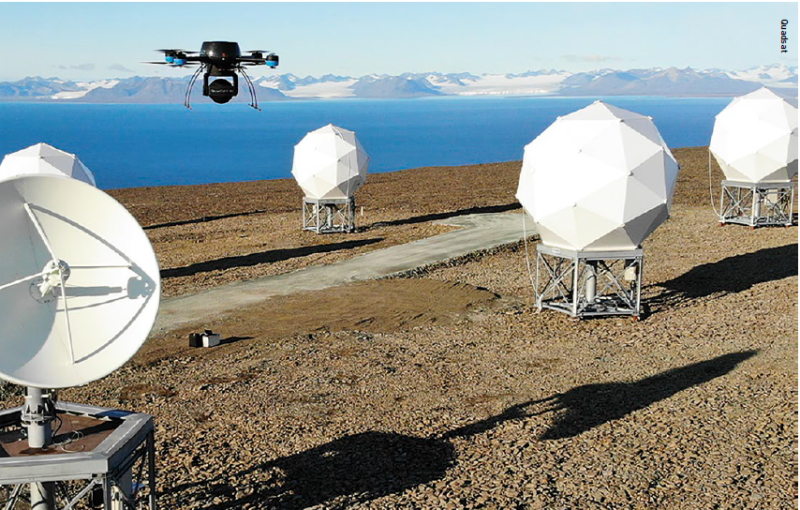 QuadSATs drone technology is fully automated and operationally flexible so it can be used anytime and anywhere.
QuadSATs drone technology is fully automated and operationally flexible so it can be used anytime and anywhere.
Conventionally, the antennas will be tested in a far-field range, a compact range and a nearfield range. However, for these classical approaches, establishing a test facility can be expensive and the test process can be logistically heavy. Also, it may not be easy to change the test set-up once established, which denies the flexibility that is often needed for testing different types of antennas with different specifications.
Another popular way of testing phased array antennas is using a simulator. In this method, the simulator samples some of the radiation pattern and, by combining the result and theoretical simulation, performs an evaluation. This is of course much easier, but the challenge here is that it relies on an assumption, rather than being able to see the real behaviour of the antenna under test.
Can drones help?
There is a growing demand for broadband connectivity on airlines, both to help ensure flight safety and to meet consumer demand to be connected everywhere
Using a drone, or unmanned aerial vehicle (UAV), means that one can perform in situ measurements where the antenna is located, rather than having to transport it to a dedicated test facility. This not only saves time and expense, but also means that one is testing in the real environment where the antenna will be active. This means that the test can take into account any environmental conditions specific to the site and makes it much easier to change the test configuration as required. By mounting a radio-frequency (RF) payload on the UAV, one can easily collect the measurement data and, most importantly, the position of the drone can be altered dynamically during measurement, which in turn allows one to easily and flexibly test with different steering angles.
Unlike more conventional antennas, for phased array antennas it is necessary to conduct the test with more than one UAV in order to track multiple beams simultaneously. This makes the test more efficient by significantly reducing the time required. Indeed, testing can be accelerated by focusing on a few key aspects, such as the transition of multiple beam peaks and their directions as steering angle is changed. Moreover, this process need not be limited to the relationship between the main lobe and neighbouring side lobes, but can include beam squint or grating lobes.
Using a drone-based approach offers the flexibility to examine the beams of interest using a dynamic measurement system. It can efficiently keep tracking any beam locations and their gains once the UAVs are located on the focused beam, regardless of any variations of the radiation pattern during measurement.
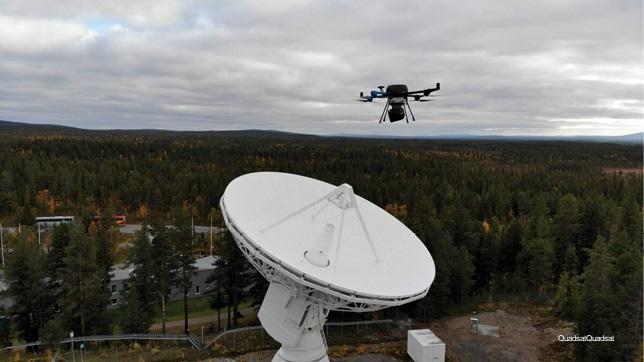 Drones can be useful in overcoming the challenges of testing large antennas.
Drones can be useful in overcoming the challenges of testing large antennas.
Practicalities
QuadSAT has done extensive research on testing phased array antennas using a drone-based system. We used the combination of a reinforcement learning-based beam localisation approach and a simple circular search algorithm. This method can provide the location and signal strength from multiple beams of interest and could drastically improve the efficiency of evaluating phased array antennas.
There are several important steps that need to be taken when testing phased array antennas:
- 1. Find the main beam by using a trained-beam localisation algorithm.
- 2. Find the side lobe area candidates by executing a circular search algorithm from the estimated main beam centre.
- 3. Find side lobe peaks by using the trained-beam localisation algorithm. The UAVs’ initial positions are defined by the angles selected from the candidates in step 2.
- 4. Locate the UAVs relative to the identified beam centres.
- 5. Slightly change the steering angle toward the desired direction to be tested.
- 6. Allow the UAVs to find the allocated beams by using the beam localisation algorithm for certain time intervals.
- 7. Locate the UAVs relative to the estimated beam centre.
- 8. Repeat the previous three steps until all the steering angles of interest are tested.
- 9. Report the measurement data which consists of the estimated beam location and measured signal strength from each examined steering angle.
This same method could be used to identify the behaviour of unwanted grating lobes, which can cause concern for phased array antenna operation as they can be harmful to other communication systems. This can also be applied for beam squint evaluation where the beam angle changes as a function of frequency.
There is no doubt that phased array antennas will be crucial for the future of satellite communications. Compact, portable and adjustable antennas open up a plethora of options to deliver communications anywhere, something that is becoming increasingly important in a more connected world. They will also help to maintain the relevance of satellites in the face of competition from other methods of communication. However, it is clear that if these systems cannot be properly tested, it will be all too easy for them to cause drastic problems on the network, which can lead to downtime for users.
The use of drones can make testing quickly and efficiently accessible, wherever the antenna is located. As well as making it easier and quicker to test, this method delivers the flexibility needed for phased array antennas, to change the testing specifications while ensuring that the real behaviour of the antenna can be viewed in its operational environment. Ultimately, this can help to keep satellite services running smoothly.
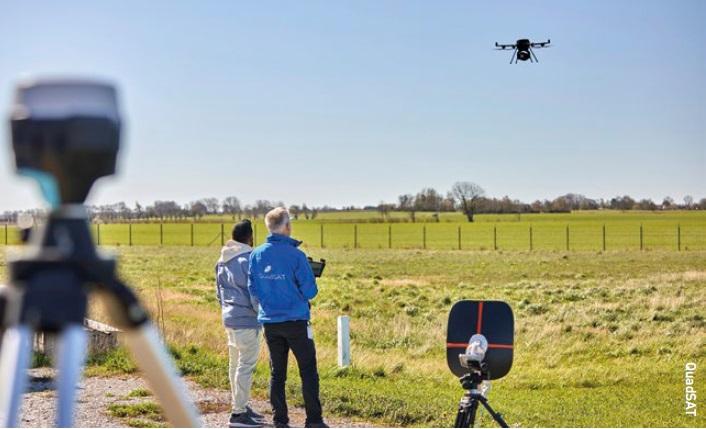 QuadSAT team operating drone on a test flight.
QuadSAT team operating drone on a test flight.
About the author
Saki Omi is a PhD student at Cranfield University, where she is sponsored by QuadSAT, a company that has developed a new way to test RF equipment in situ. Saki is working for QuadSAT alongside her PhD, mainly supporting development of intellectual property and funding application writing. Saki first worked for QuadSAT as a contractor where she developed principles for utilising swarms of UAVs to increase accuracy and efficiency of satellite antenna measurements. Saki has a BSc in Mechanical and Aerospace Engineering and an MSc in Autonomous Vehicle Dynamics and Control Engineering.





